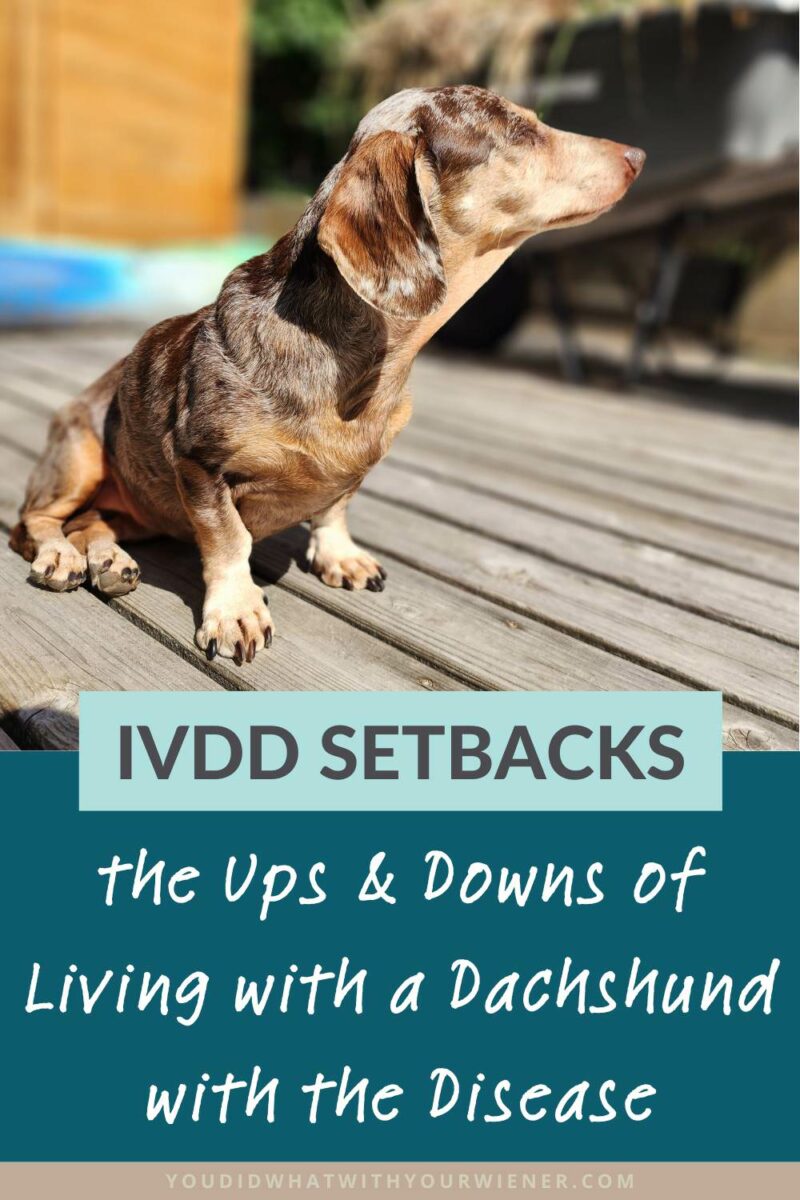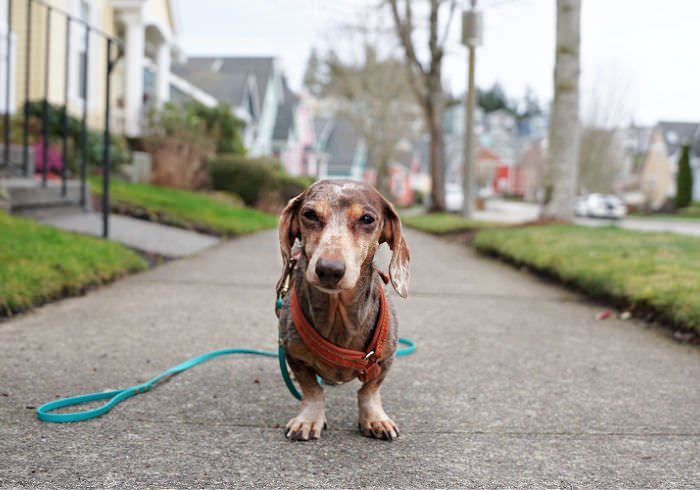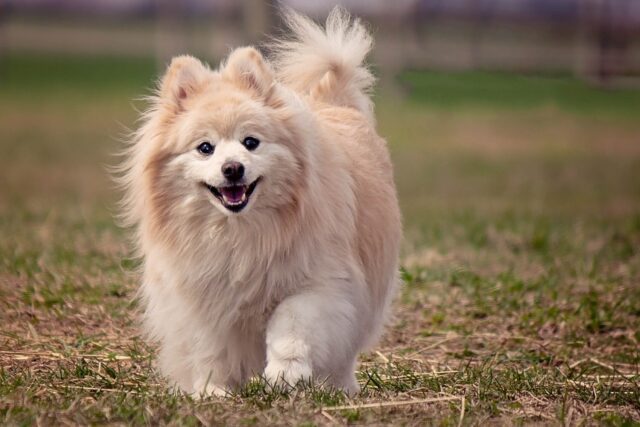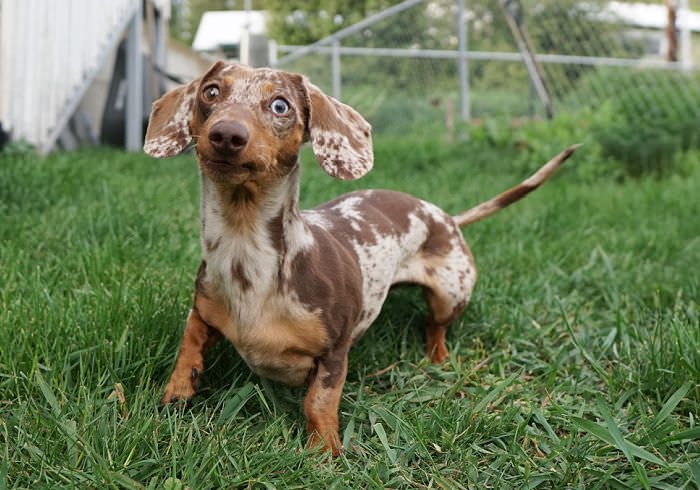I remember the day that my Dachshund Gretel was diagnosed with IVDD back in 2016. Our active life, and the future plans I had for us, flashed before my eyes.
I was devastated. And by the responses I’ve heard and seen from readers, members of our Dachshund club, and in Facebook groups, I know I am not alone.
When you get the news that your Dachshund has Intervertebral Disk Disease, you may wonder if your dog can ever live a normal life again or if you have to treat them like breakable glass for the rest of their lives.
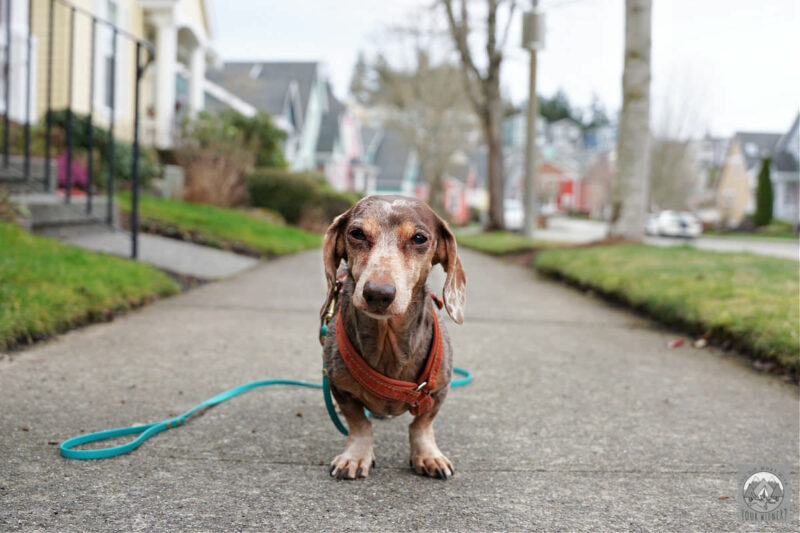
While it’s true that some Dachshunds never recover from a disk rupture due to IVDD, most will recover partially or fully, with or without surgery, depending on the degree of disk rupture and subsequent nerve damage.
However, it’s not always a straight like to recovery and, even if your Dachshund does “fully recover, IVDD is a genetic disease that can calcify disks and result in arthritis-like conditions or the future rupture of another spinal disk.
My Dachshund Gretel was diagnosed at Stage 2 – more like a disk protrusion than disk explosion – and I was very, very dedicated to her recovery.
Surgery was not recommended for her condition so we did 10 weeks of conservative treatment, which consisted of strict crate rest, cold laser treatments, acupuncture, hydrotherapy, dog strength-building exercises, and several consults with a rehabilitation veterinarian.
While she did generally progress toward recovery, there was a setback during the process.
She did fully recover that incident, and went on to live an active life, sometimes hiking again up to 15 miles in a day, but she has periodically experienced IVDD flare ups throughout her life.
My Dachshund’s Flare Up History
Since the initial IVDD-related disk episode in 2016, Gretel has experienced maybe 6 flareups.
Most were minor and not noteworthy. However, there were a few that stood out.
During recovery
When Gretel was cleared to start doing more activity, our rehab vet recommended dog physical therapy exercises for IVDD.
Since these exercises were new to me, and I needed help learning to better communicate to Gretel what I was asking her to do, we visited a dog gym and worked with a trainer.
It was my fault the flare up happened.
I had signed up for a 45-minute training session but didn’t say anything when the trainer ran over time.
Gretel was doing so well that we increased the difficulty on an exercise she had already been doing. We also tried a couple of new ones.
There were no signs that she was getting sore or tired.
As soon as walked Gretel towards the door, I could tell that something was off.
I tried to walk her across the parking lot to go potty, and she was very hesitant. I thought that was weird but not alarming.
However, by the time we got home, it was clear she was in pain. She making small, quiet grunts when I picked her up.
I did the foot flip test where you fold over their toes so the top of the foot is touching the ground and she seemed to be righting her feet without delay (a slow response can indicate nerve damage)
However, I was still concerned she was having a problem with another disc. A couple of phone calls later, we were back in the doggy ER.
The vet couldn’t find any pain points in her spine and the vet confirmed that there was no delay in flipping her her feet back over. They sent us home with more Tramadol for pain and the ant-inflammatory Meatcam.
I feared that we would have to start the crate rest and rehab all over again but they said that she was probably just sore from the workout. I was told to decrease her activity for 10 days.
I asked if I should put her on crate again and they stressed that it was only necessary to back off on the hiking and rehab exercises.
I think they didn’t want me to keep her in the crate because it might undo some of the progress we had made in her strength.
In the fall
It took me a few times to figure out that the flare ups were coinciding with the fall weather change when the air temperature changed to chilly.
Fall is when most of Gretel’s flare ups have occurred. Like people, the change in temperature and barometric pressure can aggravate old injuries.
Most of the flare ups were unremarkable – something seemed a little off so I gave Gretel an anti-inflammatory for a few days, and limited her exercise, and any mobility issues quickly resolved,
There is one flare up in particular that I remember though.
We have one step up in between our porch and the back door. Gretel normally bounds up this stair of even jumps the 18 inches to get in through the door.
One day, I was watching her. She put her front legs up on the step and tried lifting one of her back legs on.
But she couldn’t quite make it. It looked like she couldn’t raise her back leg as high as the step.
This behavior seemed more extreme than the smaller flareups that had been occurring in fall and, to be honest, I didn’t make the connection between the changing weather and her reduced mobility.
Off to the vet we went! Again, I wanted to make sure this wasn’t the early signs of another ruptured disk. Or an orthopedic injury of another kind.
After the exam, which included the foot flip test, articulation of her hips, and x-rays, the vet said it was probably the weather change aggravating her calcified disks, which are expected in Dachshunds with IVDD (and were verified by x-ray).
Again, a little pain and anti-inflammatory medication, and rest for about 10 days, and she was back to normal.
During our month-long road trip
In spring 2022, we went on a month long road trip along the west coast. The goal was to visit friends and to host Adventurewiener Club meetups.
This means there was a lot of walking, hiking, including on sandy beaches, and generally being more active than we normally are.
Half way through the trip, Gretel started acting strange. Her back was a little more hunched than normal and she wouldn’t potty for over 24 hours.
She was still eating food – she is food obsessed so it’s a tell-tale sign she is in pain if she won’t eat – so that was good but something had to be done.
I had brought her prescription of gabapentin on the trip with us so I gave her some.
After a few hours, she went potty. I was worried that her nerves were being pinched, resulting in her being unable to express her own bladder or bowels, which is common with IVDD but typically with dogs whose back legs are paralyzed.
It turns out that it was too painful for her to hunch or crouch down to potty. That’s why she was holding it.
After a phone consult with our veterinarian, and getting her prescription refilled while we were driving through the mostly-barren southeast California desert, we decided to stay on the road.
Gretel sleeps in her car seat when we drive; she mostly sleeps at camp, especially when on pain meds, and I carried her in a dog backpack when we went to events or to meet friends.
At first I felt guilty for not cutting the trip short and heading home immediately.
However, our vet assured me I was doing all the right things and my friend’s and I discussed the fact that she would be resting just the same at home so why not make it less boring for her.
This was the worst flare up she’s ever had and it lasted almost two weeks.
Are future IVDD complications inevitable?
Whether a Dachshund that suffers an IVDD disk rupture will have future complications depends on the individual dog.
I’ve known some Dachshunds who, whether through surgcial treatment or conservative treatment, made a full recovery and never experienced a flare up or another ruptured disk.
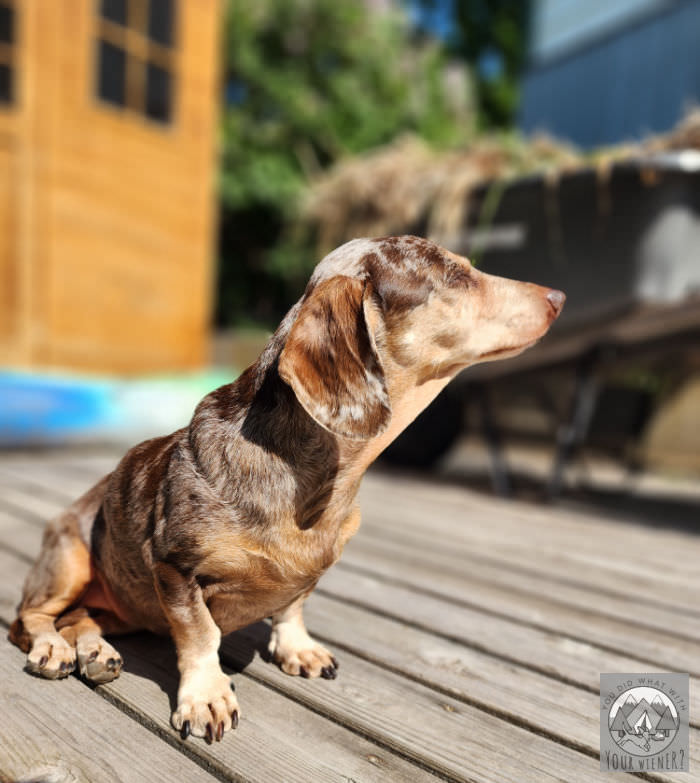
Unfortunately, I have heard of Dachshunds who rupture multiple disks in their lifetime and need more than one surgery (read: the risk of needing future surgeries).
Then there are a lot of Dachshunds who, like Gretel, experience several flare ups in their lifetime.
We’ve been fortunate that Gretel’s setbacks have been resolved in under 2 weeks. I have heard of Dachshunds who experience discomfort for a coupole months though.
In my completely anecdotal opinion, based on talking with hundreds of Dachshund owners over the years, I would estimate that:
Approximately 10{a47be734f0df8d7f120a7df290cf380c79376e8356d1aab405383bb23aa6ce67} or less of Dachshunds that recover from one rupture need surgery for another disk in the future.
Approximately 40{a47be734f0df8d7f120a7df290cf380c79376e8356d1aab405383bb23aa6ce67} recover from a disk rupture and never have another issue
Approximately 50{a47be734f0df8d7f120a7df290cf380c79376e8356d1aab405383bb23aa6ce67} of Dachshunds that suffer an IVDD-related back injury have at least one flare up in their life in the future.
Be Prepared for IVDD Setbacks
Many believe, and new studies are showing, that regular exercise is important to help prevent future complications due to IVDD.
A moderate to high level of exercise for generally healthy, adult Dachshunds help keep their spine supporting muscles strong and help keep them at the proper weight.
Some of the evidence even suggests that jumping from conservative heights, and moderate, regular use of stairs, isn’t as harmful as once thought. It might even help prevent future injuries.
But, besides keeping your Dachshund fit and at a proper weight, the best thing you can do to help manage your Dachshund from flare ups down the road is to know how to spot a flareup and know what to do about it.
Know the difference between an IVDD flare up and a new disk rupture
Only a veterinarian (I am not one) can tell you definitively if what your Dachshund is experiencing is a flare up or a new disk rupture.
However, if your dog experiences a couple flare ups, you will start to learn when a vet visit is on order and when it might be ok to just wait and see if the issue resolves.
Symptoms of a flare up mimic early signs of IVDD, but I have identified a few distinct differences between Gretel’s initial injury, and pain level, and what we’ve experienced since.
| IVDD Injury | IVDD Flare Up |
| Not wanting to move and hiding in her crate | Walking around normally but exhibiting a slight mobility issue |
| Refused all food and treats | Will enthusiastically eat |
| Yelping when picked up or touched in certain places | No yelping |
| Shaking and in obvious pain | Something is off with her behavior but not in obvious pain |
| Significant lag between when feet are flipped over and she right them | No delay or under 1 second |
Only you know your own dog. If you suspect the start of an IVDD-related disk rupture, it’s important to see a Vernerian.
Potentially, even an emergency vet because time is off the essence when it comes to disk ruptures.
However, if based on past experience, you think it’s just a flare up, you may be able to address it at home.
What to Do If Your Dog Has an IVDD Flare Up
I treat an IVDD flare up similar to how I would treat any back injury. But it’s more like “conservative treatment light”.
Conservative treatment typically includes a round of pain medication, anti-inflammatory medication, and a period of crate rest.
I keep both pain medication and anti-inflammatories on hand. Most veterinarians will prescribe extra for you to keep around home of you ask.
When I first notice something is off with Gretel, I start giving her the anti-inflammatory.
If she still looks uncomfortable, I give her a half of the recommended dose of pain medication.
The bonus is that this medication usually makes her sleepy, so she is more likely to just lay around and sleep.
I also have a cold laser for home use so I start giving her treatments to help reduce pain and inflammation.
While I don’t put her on strict crate rest, I do limit her activity, which includes putting her in her crate when I can’t supervise her, until she has improved (usually 1-2 weeks).
If I want to take her out for a “walk”, I push her in her stroller.
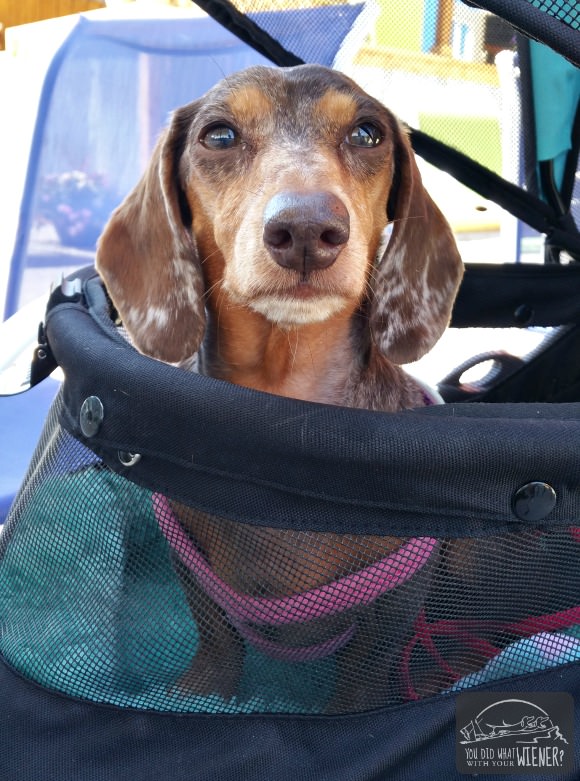
Final Thoughts
I’ve been dealing with a back problem for over 15 years. Since the injury, my life has been a series of active periods and recovery periods.
That’s often the way it is with dogs too – the initial injury comes back to nag at them when the weather changes with the seasons, if they tweak something during exercise, or they just happen to wake up that way.
My goal is to let my Dachshund live a happy, fulfilled, active, healthy life so that means letting her “be a dog”.
But I am always monitoring her for changes and am prepared to take whatever action needed if I detect a flare up or I think she has ruptured another disk.
Like I have, I think it’s important to recognize that living with an IVDD dog can be filled with ups and downs – with good times and times when mobility is limited and discomfort must be managed.
But, except for a few, small modifications, life with an IVDD Dachshund who has recovered from their initial injury can be just as enjoyable as with any other dog.
